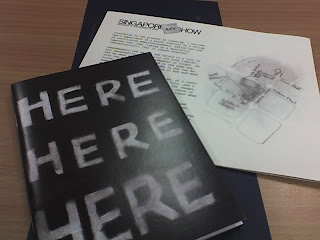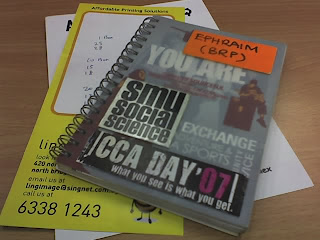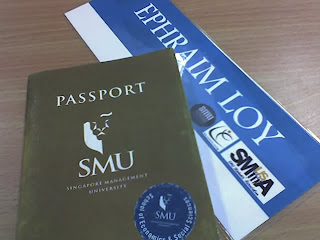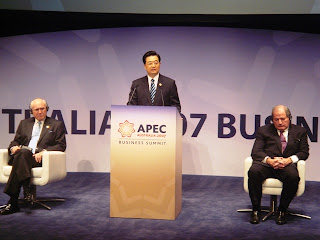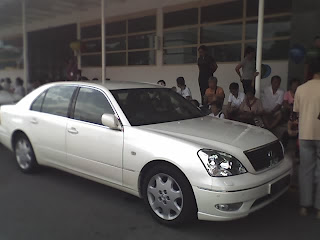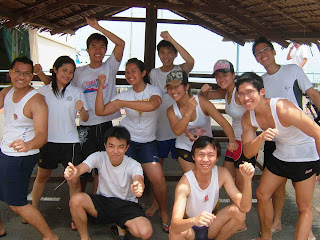[CPF changes are main concern at dialogue]Yesterday, grassroots leaders in Aljunied GRC were invited to air their views in a Post National Day Rally 2007 Dialogue. The session started on a different note this time. Instead of the participants asking the questions, the inertia picked up with Minister of State (Finance) and (Transport), Mrs Lim Hwee Hua’s question: what would you do if the situation is such that you live past the 85-year-old mark?
The dialogue was to discuss on issues that the Prime Minister highlighted in his rally speech but was centered on CPF changes.

Mrs Lim added that the Government still chose to discuss about changes to the CPF though unpopular because the Singapore Government is a “responsible Government”. She also brought up an example of sustainability and discussed it using General Motors as an example. General Motors had a retirement plan that even provided pensions for everyone such that in order to keep up with its obligations, that for every $1 earned, $0.30 would go towards meeting earlier obligations. The company declared bankruptcy in the end.
“The Government cannot just declare itself bankrupt (in the case of General Motors), it has to deliver promises to Singaporeans”, she said.
One grassroots leader asked about the Government’s role in providing sufficient and affordable healthcare adding that such costs may be a burden on the family.
Another said she would probably live past 85 as her grandparents did and if by any measure of genetics, she would too. Her concern was whether one would be able to work for long hours. To that, she suggested having a scheme to allow flexible working hours so that those that are 65 years and above could continue to contribute to the workforce (and CPF).
“It’s sort of like a semi-retirement but one is still able to contribute to the workforce” she explained.
Others questioned the annuities scheme citing high premium rates. However, he added that this would set the pace for the younger generation to realise that it is important to start investing in annuities from young.
Yet another asked if the CPF board could enroll a large group of Singaporeans at once to benefit from “economies of scale” does lowering the premium each has to pay. “It’ll be better value for money”, he added.
Summing the thoughts, Mrs Lim acknowledged the three key points – self-esteem, the elderly not wanting to be a burden to the family and to the younger generation, having options to change housing types and to minimise requirements for help.
Aljunied GRC MP Yeo Guat Kwang on the other hand touched on tripartite efforts to get older people to work beyond 62 and the plans to create enough job opportunities for those who want to work longer. It’s sort of like the saying “same same but different” – not the same job, not same pay but still working.
“We do not want to be like in other countries where they just raise the retirement age. We do not want to stretch them but we are prepared to let them work as they wish.”
And this is where job-recreation comes in. Such re-created jobs will be tailored so that those who grow older can manage and stay employed.
NorthEast CDC Mayor Zainul Abidin Rasheed brought the crowd to much laughter when he told them the jist of it was “money got enough?” He spoke about the three Ls – life needs, life skills and lifestyles and added that the CDCs would continue to help those that needed help. In Sweden, people pay taxes of 50% to 55%. Singapore cannot afford to do that as we need to attract more industries and create more jobs. He cited Minister Mentor Lee Kuan Yew as an example.
He said: “If MM retired at 60, we would have lost 20 years of his contributions to Singapore. But he continues to work as long as he can to keep his mind active.”
And that is what he hopes will come to fruition – active minds and self-reliance. Don’t have the mindset that the children will look after you, they have their priorities too. And don’t expect the Government to. But the Government will still spend billions of dollars to have schemes like Workfare and WIS but the basis is that one has to work to be able to also depend on the Government unlike in welfare states.
A real life example was citied when it was Aljunied GRC MP Mdm Cynthia Phua’s turn to speak. She spoke of the re-adjustment of work scope where a former property officer, at 62, took a 35% pay cut to do a customer service job. To date, she has adjusted well and has even learnt how to use the computer. And she believes that senior citizens must upgrade too. And that is why the Paya Lebar CC (in her Paya Lebar ward) has a computer class that teaches Internet skills and online account creation skills targeted at senior citizens at a low cost rate of $10. Her key points were re-work, re-think and to re-skill.
Citing the growth of the GIC and Temasek Holdings, one asked whether it would be sensible to give more than the additional 1% interest rate on $60,000. He also added that one would yield much more by investing in bond and equities however, he did note that CPF had risk-free rates.
To that, the response was that investment gains from GIC and Temasek Holdings are pumped back into the annual budget. There are also some years when these investments do not have returns (but losses). Also, an additional 1% increase would be equivalent to some $700 million.
Another asked how these schemes would be misused citing the current surge of foreigners into Singapore. How would the Government tackle the situation when a foreigner brings his whole family along and reaps the benefits of the CPF scheme.
Answering that question, Mrs Lim explained that Singapore does not give welfare benefits. The foreigner has to contribute to Singapore’s economy and show commitment in order to be granted PR or citizenship. We have to have a balance. Ultimately, we are a selfish country.
Mayor Zainul added that Singapore is developing the creative and high-tech industries and these require young creative talent.
“We have to be prepared to let them in but we have to maintain a balance and know they are going to contribute”, he said.
Though they have different cultures and habits, management of foreign talent is the key.
Mr Yeo added that there have been policy revisions that allow citizens more benefits over PRs. One such policy is the cost of lift upgrading where citizens pay only 5% while foreigners pay the full cost. Hospital subsidies are also treated differently for citizens and PRs he added. He further explained that there is a very slim chance for foreigners aged 50 and above to become citizens.
In a city when there is a need for more people to sustain economic growth, such efforts to attract talent are necessary.
The panel further explained details on schemes available for those not contributing to their CPF accounts – for example housewives. Cash and CPF monies can be used to top up CPF accounts so as to enable the spouse to withdraw his/her portion of the CPF for retirement.
Another concern was ensuring that employers continue to employ and not discriminate against elderly workers. Mr Yeo said that there are schemes in place to ensure that. Mrs Lim also added that good employers would be constantly acknowledged while bad ones are pointed out.
Ultimately the strong message was for the elderly to “age gracefully and actively”.
“It is a package of difficult decisions and the Government will make it sustainable”, said Mrs Lim.
Summing up, Mayor Zainul said: “We looked at different models – Europe, Japan - and we decided to model it after Japan and we continue to make adjustments as time goes by.”
On the issue of basic annuities, Mr Yeo said “there are lots of worries but this is because the full details are not out yet”.
Mdm Phua added that one has “to change attitudes and mindsets and anchor lifestyles with the family”.
Surprisingly, there were no questions regarding Singapore's decision to have a fourth university or the language schemes in schools. No one asked about the plans for Punggol 21 + and changes to housing policies.

















